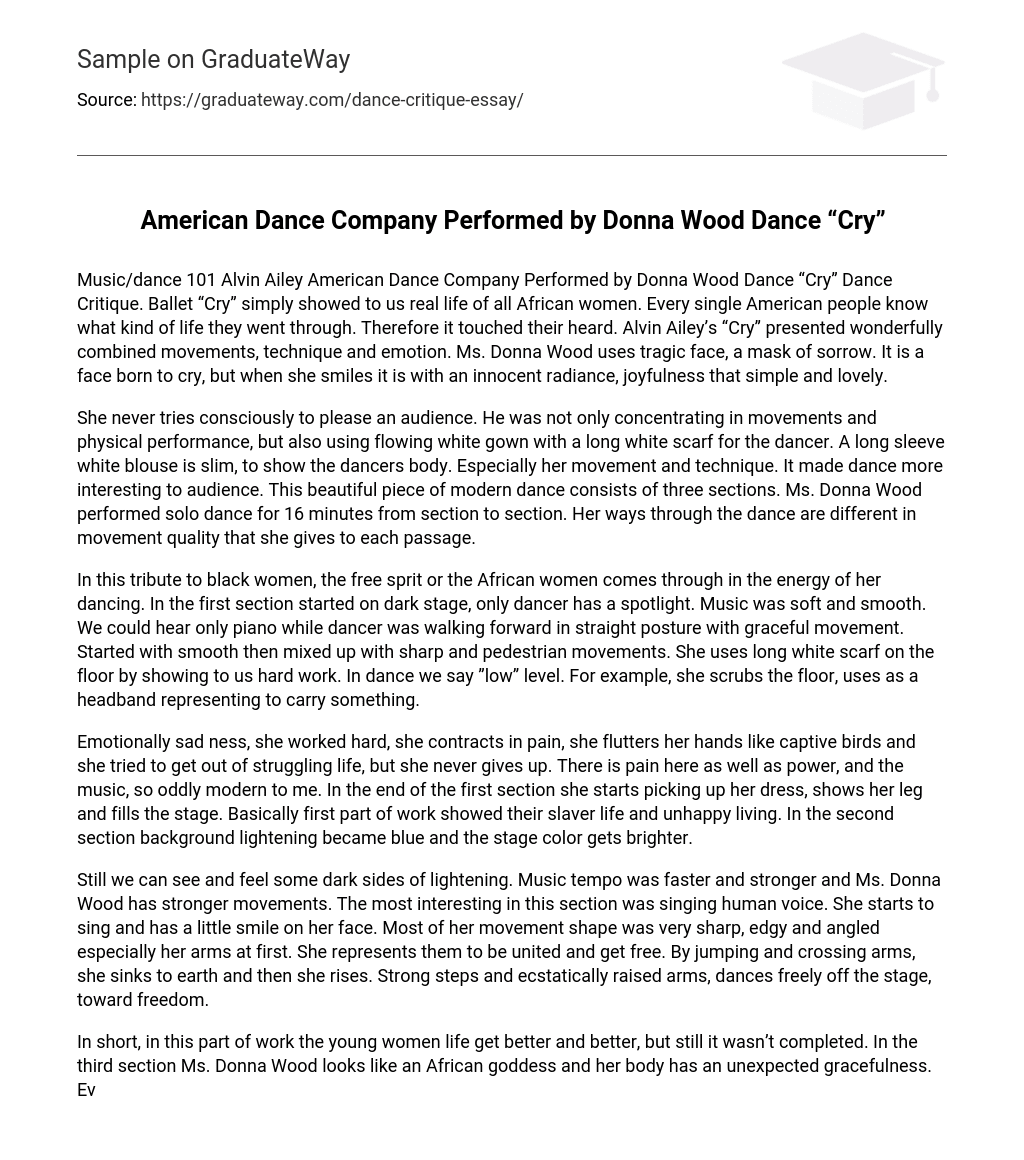Ballet “Cry” depicted the authentic experiences of African women, a life that many Americans are familiar with. As a result, it deeply moved them. Alvin Ailey’s “Cry” masterfully integrated dance movements, technique, and emotions. Ms. Donna Wood portrayed a tragic expression, wearing a mask of sorrow. Her face was naturally inclined towards crying, yet when she smiled, it exuded an innocent and radiant joyfulness that was both simple and beautiful.
She does not make a conscious effort to please the audience. He focused not only on his movements and physical performance, but also on wearing a flowing white gown and a long white scarf as a dancer. The slim white blouse with long sleeves was used to highlight the dancer’s body and showcase her movement and technique, making the dance more captivating for the audience. This stunning contemporary dance piece is divided into three sections, with Ms. Donna Wood performing a solo dance for 16 minutes, transitioning from section to section. Each passage in her dance displays a distinct movement quality.
This tribute celebrates black women and showcases the free spirit of African women through their energetic dancing. The performance begins on a dark stage, with only one dancer illuminated by a spotlight. The music is soft and smooth, with just the sound of a piano in the background. The dancer moves gracefully, with a straight posture, while walking towards the audience. The dance starts off with smooth movements but later incorporates sharp and pedestrian movements. To represent hard work, the dancer uses a long white scarf on the floor, mimicking scrubbing motions and even using it as a headband to symbolize carrying something. All these elements combine to create a powerful performance that honors black women.
Emotionally, she experiences sadness and works diligently. She is burdened with pain and anxiously moves her hands like captive birds, desperately attempting to escape a difficult life. Despite the hardships she faces, she never loses her determination. This performance encompasses both pain and strength, with the music having an unusually contemporary feel. In the conclusion of the first section, she lifts her dress, exposing her leg and dominating the stage. Essentially, the initial part of the performance portrays a life of servitude and unhappiness. In the subsequent section, the lighting changes to a blue hue, enhancing the brightness of the stage.
Despite the positive effects of lightening, there were also some negative aspects. The music had a faster and stronger tempo, and Ms. Donna Wood’s movements were stronger as well. The highlight of this section was the human voice singing. With a small smile on her face, she began to sing. Her movements were predominantly sharp and angular, particularly her arms. She portrayed unity and liberation through jumping and crossing her arms, symbolizing sinking to the ground and then rising up. With powerful steps and arms raised in ecstasy, she danced off the stage towards complete freedom.
In this part of the work, the young woman’s life improves gradually but remains incomplete. In the third section, Ms. Donna Wood appears as an African goddess and her body possesses an unexpected grace. The stage is illuminated with a bright reddish color, creating a warm atmosphere reminiscent of a sunrise in the morning. The stage becomes filled with vibrant colors as the music and performer harmonize. The tempo of the music increases, and Ms. Donna Wood exudes pure happiness, devoid of pain and slavery. She jumps, swings her legs and arms, and even lifts her dress to reveal her entire dance.
The use of sound and lighting creates an environment and atmosphere that puts people in a good mood. The dancer, Ms. Donna Wood, showcases a higher level of dance compared to the previous two sections. She seamlessly moves between different melodies, and I particularly enjoyed how she utilizes the stage in this particular section. Despite dancing alone, she effortlessly covers a significant amount of space with her high energy. Ultimately, in her performance of “be free,” Ms. Donna Wood portrays her own interpretation of black power and black pride. To summarize, the solo dance titled “Cry” by Ms. Donna Wood consists of three sections and lasts for 16 minutes. It depicts the journey of an African woman from the hardships of slavery to a state of pure grace on stage.
She dances with a graceful and poised beauty, exuding a sense of serenity, sophistication, and femininity. Although she maintains a certain distance from the audience, it is more out of reservation than shyness. What stands out is her evident pride, evident in the flawless alignment of her head on a long and strong neck. The staging reflects simplicity at its best, with the lighting playing a crucial role in enhancing and adapting the impact of each segment. With her angular and precise movements, Ms. Donna Wood concludes the performance on a thrilling note. It is worth noting that Alvin Ailey created this piece specifically for her, as a birthday gift for his mother.





